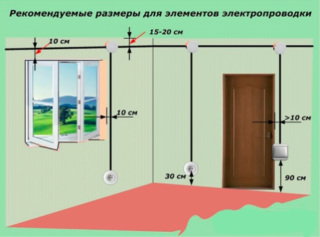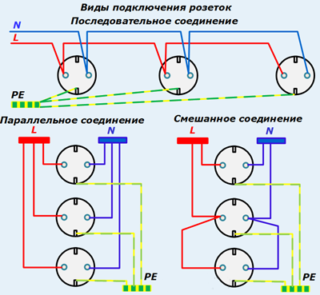Modern electrical equipment makes life easier and creates an increased load on the wiring, which cannot always cope with it. This is especially true for buildings that were built in the middle to the end of the last century. Outdated cables and improper installation lead to overheating of lines and short circuits. In order not to face such unpleasant and dangerous phenomena, you need to know what the electrical wiring in the apartment is, the rules and regulations for its installation.
Basic documents
The norms for laying electrical wiring in residential premises are regulated by the following acts:
- Electrical Installation Rules (PUE) - planning and installation, connections and switching, use of materials.
- GOST 31565-2012 - fire safety, fire prevention.
- GOST 50571.15-97 - rules for laying lines, methods of installation on various surfaces.
- SP 256.1325800.2016 - grounding and safety, insulation and dimensions.
- SNiP 31-110-2003 - placement of devices, distance and installation locations.
Violation of the rules for laying wiring in an apartment entails administrative and material liability.
The importance of applying standards
Compliance with the standards of electrical wiring in the apartment is achieved by the exact fulfillment of the requirements of legislative acts.
The importance of their application is as follows:
- selection of conductors, the cross-section of which corresponds to the power of consumers;
- elimination of the risk of electric shock to people;
- optimal location and correct selection of the required number of outlets;
- prevention of the risk of fire in the network;
- prevention of breakdowns of household appliances.
If you strictly follow the SNiPs for electrical installation, you can correctly calculate the need and type of conductors, which helps to reduce the construction budget.
The main points of the requirements and rules
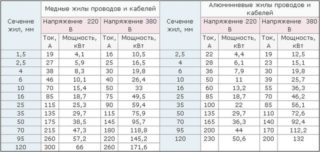
The rules for laying electrical wiring cover a wide range of aspects of installation, from the choice of materials to the procedure for putting the structure into operation.
Minimum cable cross-section:
- introductory - 4 mm;
- sockets - 2.5 mm;
- lighting group - 1 mm.
Number of conductor cores:
- single-phase line - 2;
- single-phase network with grounding - 3;
- two-phase supply - 3;
- two-phase network with grounding - 4.
- floor - 30-120 cm;
- panel joints - 20 cm;
- window and door openings - 10 cm;
- sewer and water pipes - 30 cm;
- sinks, baths - 50 cm;
- heating devices - 20 cm;
- electric stoves - 15 cm;
- gas lines - 40 cm.
Wiring types:
- with isolation of one and several colors;
- copper and aluminum;
- with regular and non-combustible coating.
- batch type;
- relay;
- fusible;
- electronic.
Line layout diagrams:
- sequential;
- parallel;
- combined.
Requirements for the installation of electrical wiring apply to residential and auxiliary premises, including loggias, balconies and vestibules.
Installation of hidden wiring
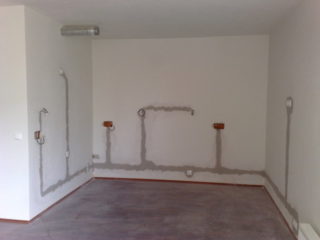
Hidden cable laying is carried out in buildings made of concrete, bricks and gas silicate blocks. This approach is considered the safest, but laborious, since it is necessary to carry out a large amount of drilling and plastering work.
Wiring requirements determine its installation in the base:
- Within the walls. Preliminarily, strobes are made from the junction box to the hole for the outlet or switch. Rectangular or triangular grooves can be cut. After that, wires or plastic tubes are attached to them, into which the cable is subsequently tightened.
- Under the floor. The activity is carried out during the construction phase or the replacement of the wooden covering. Laying requires a minimum of effort. The disadvantage is that there is a risk of damage to the insulation by cockroaches and mice, which are often found in the underground. Another disadvantage is the large amount of work to lead the lines to the ceiling lamp and switches.
- On the ceiling. The best option is to pull communications into the voids of the floor slabs. If this is not possible, grooves are made in the plaster layer, in which the wiring is walled up. Do not cut the base plate.
When choosing a laying method, the financial side of the issue is taken into account. If you do the installation on the floor, the consumption of an expensive cable will be large.
Installation of open wiring
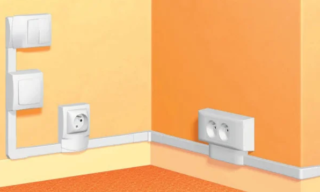
Installation of open wiring is carried out in buildings made of wood, shields, panels and other combustible materials. When designing, it must be borne in mind that the distance of the wiring from the ceiling should be at least 2 cm, and the floor outlets should be no more than 1 meter. When laying lines, it is forbidden to use nails, staples and screws to fasten the cable directly to the supporting surface.
The following installation options are established by regulatory documents:
- flexible corrugated tubes;
- rigid round and rectangular plastic profiles;
- metal sleeves with threaded connections;
- polymer cable channels;
- hollow split platbands and skirting boards;
- steel strings;
- ceramic insulators.
Since such structures look unaesthetic on the ceiling, there are several ways to disguise them. For this, tension structures, suspension systems from gypsum boards, plastic panels and metal rails are used.
Installation methods for sockets and switches
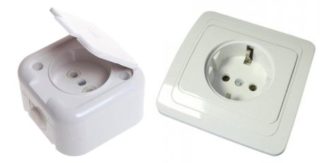
Installation of sockets and switches, as well as wiring, can be done in an open and closed way.
The first option is used for the arrangement of premises, the walls of which are made of combustible materials or their thickness is insufficient for the installation of mounting boxes (socket boxes). In some cases, such a decision is made to save time and effort during the construction process or when a previously laid wiring fails. Fastening is carried out directly to the supporting surface. The disadvantages of outdoor installation are that the instrument cases protrude 4-6 cm above the surface of the walls and spoil the interior of the premises. In addition, the likelihood of damage or demolition of the product increases with careless movement, transfer of furniture and large household appliances.
The closed way of mounting the socket can be used in combination with all types of cable routing. Previously, holes are made in the wall into which plastic glasses are attached to the putty. After the solution crystallizes, the socket is connected to the wires and rigidly fixed in a plastic box. If you do not take into account the complexity of chasing and drilling holes, this method is safer, more practical and more aesthetically pleasing.
Compliance with standards
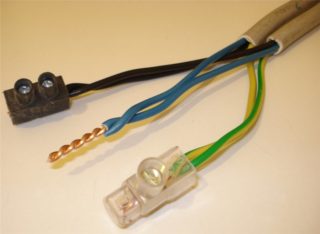
When carrying out electrical work in residential premises, it is necessary to comply with the standards established for them with respect to the following parameters:
- Section of veins. You need to choose conductors with the calculation of the maximum load that will affect them. When the permissible power is exceeded, the metal heats up, which leads to the formation of smoke, melting of the insulation and the risk of fire.
- Laying of lines. Fragments of the network can be located only in the vertical and horizontal directions, they should not intersect each other during internal installation. The outlet groups should be equidistant from the floor.
- Commutation. The main rule is to prohibit direct connection of copper and aluminum conductors. To do this, use an indirect mating in bolt with nut, busbars or spring terminals. Single-metal wires can be twisted and then insulated.
- Location. The slightest likelihood of mechanical damage, melting of the wiring elements and ingress of water into them should be excluded.
Compliance with standards is the basis for the safety and durability of the structure.
Rules for different types of transactions
When choosing wiring for equipment of various types of premises, the rules set out in GOST 12.1.044 should be observed. For residential buildings, three-core cables with copper conductors of 1-2.5 mm must be used. Insulation must be non-combustible and smoke-free when heated. These parameters correspond to brands VVG-Pngd, VVGzngd, Flame-X, N2XH, YnKY.
For the arrangement of premises made of non-combustible materials, the use of simple conductors is allowed without any restrictions. A separate line equipped with an RCD should be extended to powerful consumers operating in a continuous mode.


